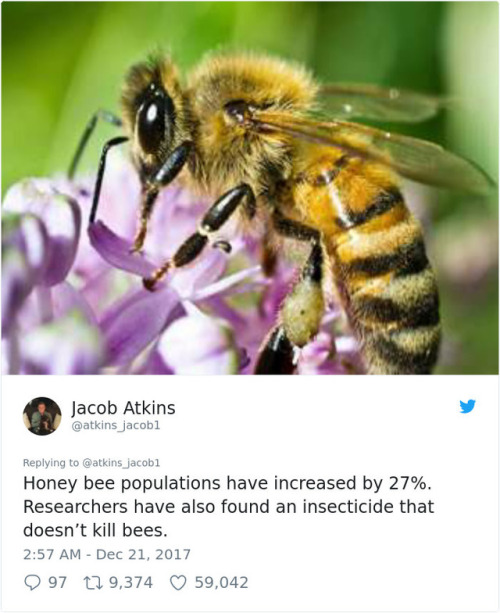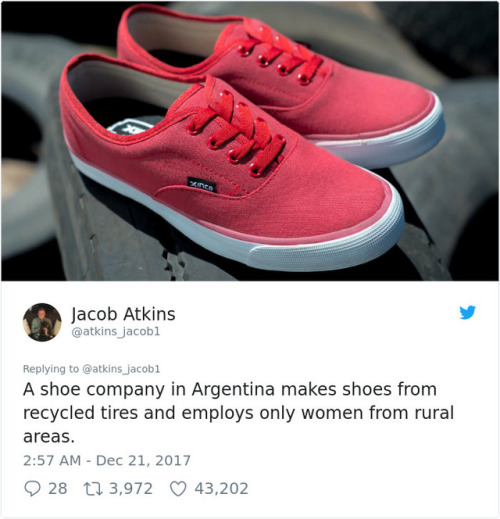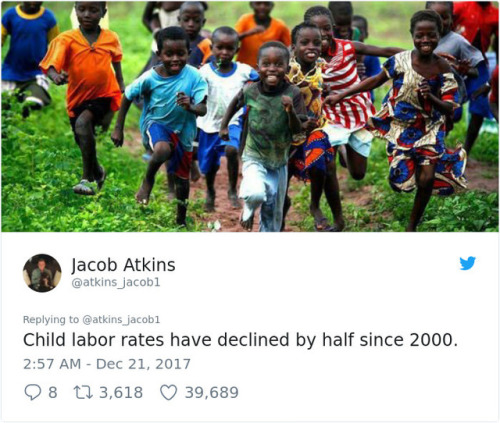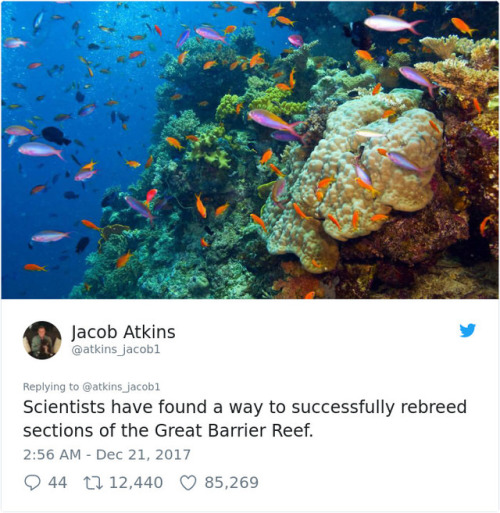Good News Of 2017









Good News of 2017
More Posts from Redplanet44 and Others
““One of the holy grails of biomaterials research has been working out a way to get skin to grow onto and attach to metals and plastics without the risk of infection. It looks like this design and technique may have solved the problem,” says Dr Stynes, who is researching his PhD at the University of Melbourne. “It could pave the way for fully implantable robotics, prosthetics, catheters, intravenous lines, and the reconstruction of surgical defects with artificial materials.” Professor Richard Page, Director of Orthopaedics and the Centre of Orthopaedic Research and Education at Barwon Health and Deakin University, said the ability of the scaffold to make the skin think it was growing on other skin is potentially a major finding.”
— Breaking the Skin Barrier Can Lead to Breakthroughs in Robotics to Human Interface
A woman in Nevada dies from a bacterial infection that was resistant to 26 different antibiotics. A U.K. patient contracts a case of multidrug-resistant gonorrhea never seen before. A typhoid superbug kills hundreds in Pakistan. These stories from recent years — and many others — raise fears about the possibility of a post-antibiotic world.
The development of antibiotics in the early 20th century was one of the greatest leaps forward of modern medicine. Suddenly, common illnesses like pneumonia, strep throat and gonorrhea were no longer potential death sentences.
But even in the infancy of antibiotics, it was clear that their misuse and overuse could lead to antibiotic resistance and eventually create untreatable superbugs.
In this video, we explain how antibiotic resistance happens — and what we can do to avoid living in a post-antibiotic world.
Video: NPR






Tyson fights like Tyson with words





8.28.17

Polymer researchers discover path to sustainable and biodegradable polyesters
There’s a good chance you’ve touched something made out of the polyolefin polymer today. It’s often used in polyethylene products like plastic bags or polypropylene products like diapers.
As useful as polyolefins are in society, they continue to multiply as trash in the environment. Scientists estimate plastic bags, for example, will take centuries to degrade.
But now, researchers at Virginia Tech have synthesized a biodegradable alternative to polyolefins using a new catalyst and the polyester polymer, and this breakthrough could eventually have a profound impact on sustainability efforts.
Rong Tong, assistant professor in the Department of Chemical Engineering and affiliated faculty member of Macromolecules Innovation Institute (MII), led the team of researchers, whose findings were recently published in the journal Nature Communications.
One of the largest challenges in polymer chemistry is controlling the tacticity or the stereochemistry of the polymer. When multiplying monomer subunits into the macromolecular chain, it’s difficult for scientists to replicate a consistent arrangement of side-chain functional groups stemming off the main polymer chain. These side-chain functional groups greatly affect a polymer’s physical and chemical properties, such as melting temperature or glass-transition temperature, and regular stereochemistry leads to better properties.
Read more.

Journal reference: Cell Reports
Manual isolation of a single live mitochondria. The mitochondria can be seen under a microscope where a thin glass tube can be used to isolate the mitochondria from the dendrite region of the mouse neuron. Credit: Jacqueline Morris and Jaehee Lee, Perelman School of Medicine, University of Pennsylvania

New process allows 3-D printing of nanoscale metal structures
Synthesizing organic scaffolds that contain metal ions enables 3-D printing of metallic structures that are orders of magnitude smaller than previously possible
For the first time, it is possible to create complex nanoscale metal structures using 3-D printing, thanks to a new technique developed at Caltech.
The process, once scaled up, could be used in a wide variety of applications, from building tiny medical implants to creating 3-D logic circuits on computer chips to engineering ultralightweight aircraft components. It also opens the door to the creation of a new class of materials with unusual properties that are based on their internal structure. The technique is described in a study that will be published in Nature Communications on February 9.
In 3-D printing – also known as additive manufacturing – an object is built layer by layer, allowing for the creation of structures that would be impossible to manufacture by conventional subtractive methods such as etching or milling. Caltech materials scientist Julia Greer is a pioneer in the creation of ultratiny 3-D architectures built via additive manufacturing. For instance, she and her team have built 3-D lattices whose beams are just nanometers across – far too small to be seen with the naked eye. These materials exhibit unusual, often surprising properties; Greer’s team has created exceptionally lightweight ceramics that spring back to their original shape, spongelike, after being compressed.
Greer’s group 3-D prints structures out of a variety of materials, from ceramics to organic compounds. Metals, however, have been difficult to print, especially when trying to create structures with dimensions smaller than around 50 microns, or about half the width of a human hair.
Read more.

Scientists make research ‘jelly’ grow more like biological tissues
Opens up new possibilities in tissue engineering and soft robotics
Scientists from Nanyang Technological University, Singapore (NTU Singapore) and Carnegie Mellon University (CMU) have found a way to direct the growth of hydrogel, a jelly-like substance, to mimic plant or animal tissue structure and shapes.
The team’s findings, published in Proceedings of the National Academy of Sciences today, suggest new applications in areas such as tissue engineering and soft robotics where hydrogel is commonly used. The team has also filed a patent at CMU and NTU.
In nature, plant or animal tissues are formed as new biomass is added to existing structures. Their shape is the result of different parts of those tissues growing at different rates.
Mimicking this behaviour of biological tissues in nature, the research team comprising CMU scientists Changjin Huang, David Quinn, K. Jimmy Hsia and NTU President-designate Prof Subra Suresh, showed that through manipulation of oxygen concentration, one can pattern and control the growth rate of hydrogels to create the desired complex 3D shapes.
Read more.

Thats amazing news :O
A battery that eats CO2

By Khai Trung Le
A new type of battery developed by researchers at MIT could be made partly from carbon dioxide captured from power plants. Rather than attempting to convert carbon dioxide to specialized chemicals using metal catalysts, which is currently highly challenging, this battery could continuously convert carbon dioxide into a solid mineral carbonate as it discharges.
The battery is made from lithium metal, carbon, and an electrolyte that the researchers designed. While still based on early-stage research and far from commercial deployment, the new battery formulation could open up new avenues for tailoring electrochemical carbon dioxide conversion reactions, which may ultimately help reduce the emission of the greenhouse gas to the atmosphere.
Currently, power plants equipped with carbon capture systems generally use up to 30 percent of the electricity they generate just to power the capture, release, and storage of carbon dioxide. Anything that can reduce the cost of that capture process, or that can result in an end product that has value, could significantly change the economics of such systems, the researchers say.
Betar Gallant, Assistant Professor of Mechanical Engineering at MIT, said, ‘Carbon dioxide is not very reactive. Trying to find new reaction pathways is important.’Ideally, the gas would undergo reactions that produce something worthwhile, such as a useful chemical or a fuel. However, efforts at electrochemical conversion, usually conducted in water, remain hindered by high energy inputs and poor selectivity of the chemicals produced.
The team looked into whether carbon-dioxide-capture chemistry could be put to use to make carbon-dioxide-loaded electrolytes — one of the three essential parts of a battery — where the captured gas could then be used during the discharge of the battery to provide a power output.
The team developed a new approach that could potentially be used right in the power plant waste stream to make material for one of the main components of a battery. By incorporating the gas in a liquid state, however, Gallant and her co-workers found a way to achieve electrochemical carbon dioxide conversion using only a carbon electrode. The key is to preactivate the carbon dioxide by incorporating it into an amine solution.
‘What we’ve shown for the first time is that this technique activates the carbon dioxide for more facile electrochemistry,’ Gallant says. ‘These two chemistries — aqueous amines and nonaqueous battery electrolytes — are not normally used together, but we found that their combination imparts new and interesting behaviors that can increase the discharge voltage and allow for sustained conversion of carbon dioxide.’
The battery is made from lithium metal, carbon, and an electrolyte that the researchers designed. While still based on early-stage research and far from commercial deployment, the new battery formulation could open up new avenues for tailoring electrochemical carbon dioxide conversion reactions, which may ultimately help reduce the emission of the greenhouse gas to the atmosphere.
-
 factfvckswithfiction liked this · 1 month ago
factfvckswithfiction liked this · 1 month ago -
 brittabengtson liked this · 1 month ago
brittabengtson liked this · 1 month ago -
 arougeme liked this · 1 month ago
arougeme liked this · 1 month ago -
 arcadewinter42 liked this · 2 months ago
arcadewinter42 liked this · 2 months ago -
 ladamelou liked this · 3 months ago
ladamelou liked this · 3 months ago -
 raylafan101 liked this · 3 months ago
raylafan101 liked this · 3 months ago -
 kvethashurtugal liked this · 3 months ago
kvethashurtugal liked this · 3 months ago -
 crystalklk liked this · 3 months ago
crystalklk liked this · 3 months ago -
 alexthespaceace liked this · 3 months ago
alexthespaceace liked this · 3 months ago -
 caffeinatedmoonboy liked this · 4 months ago
caffeinatedmoonboy liked this · 4 months ago -
 ladyofthetempest liked this · 5 months ago
ladyofthetempest liked this · 5 months ago -
 annan7ezv liked this · 6 months ago
annan7ezv liked this · 6 months ago -
 annita89q8i6jph liked this · 6 months ago
annita89q8i6jph liked this · 6 months ago -
 anna1xy47 liked this · 6 months ago
anna1xy47 liked this · 6 months ago -
 hurricane105 reblogged this · 6 months ago
hurricane105 reblogged this · 6 months ago -
 hurricane105 liked this · 6 months ago
hurricane105 liked this · 6 months ago -
 multidimensionalfang1rl liked this · 7 months ago
multidimensionalfang1rl liked this · 7 months ago -
 sunnydoggyboi liked this · 7 months ago
sunnydoggyboi liked this · 7 months ago -
 aluade liked this · 8 months ago
aluade liked this · 8 months ago -
 re-dutos liked this · 10 months ago
re-dutos liked this · 10 months ago -
 clagerhideout768 liked this · 11 months ago
clagerhideout768 liked this · 11 months ago -
 kiwi-kuns-art-tumb reblogged this · 1 year ago
kiwi-kuns-art-tumb reblogged this · 1 year ago -
 kiwi-kuns-art-tumb reblogged this · 1 year ago
kiwi-kuns-art-tumb reblogged this · 1 year ago -
 kiwi-kuns-art-tumb liked this · 1 year ago
kiwi-kuns-art-tumb liked this · 1 year ago -
 badideago liked this · 1 year ago
badideago liked this · 1 year ago -
 yourlocalhumanoid reblogged this · 1 year ago
yourlocalhumanoid reblogged this · 1 year ago -
 yourlocalhumanoid liked this · 1 year ago
yourlocalhumanoid liked this · 1 year ago -
 autistic-shroom-trip reblogged this · 1 year ago
autistic-shroom-trip reblogged this · 1 year ago -
 autistic-shroom-trip liked this · 1 year ago
autistic-shroom-trip liked this · 1 year ago -
 scienceofwilderness liked this · 1 year ago
scienceofwilderness liked this · 1 year ago -
 noisett-e liked this · 1 year ago
noisett-e liked this · 1 year ago -
 violntfemme liked this · 1 year ago
violntfemme liked this · 1 year ago -
 weeklypolygon liked this · 1 year ago
weeklypolygon liked this · 1 year ago -
 thepimpunicorn liked this · 1 year ago
thepimpunicorn liked this · 1 year ago -
 idulatvemel liked this · 1 year ago
idulatvemel liked this · 1 year ago -
 papeporlaris liked this · 1 year ago
papeporlaris liked this · 1 year ago -
 amethystunicorn2727 liked this · 1 year ago
amethystunicorn2727 liked this · 1 year ago -
 baked-bean-sin reblogged this · 1 year ago
baked-bean-sin reblogged this · 1 year ago